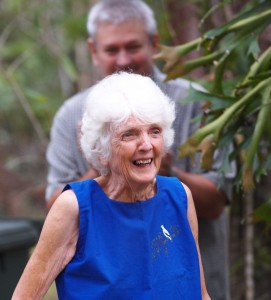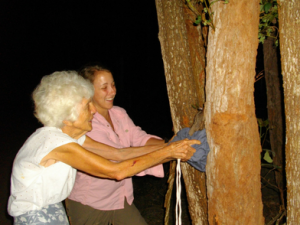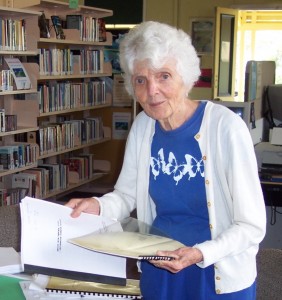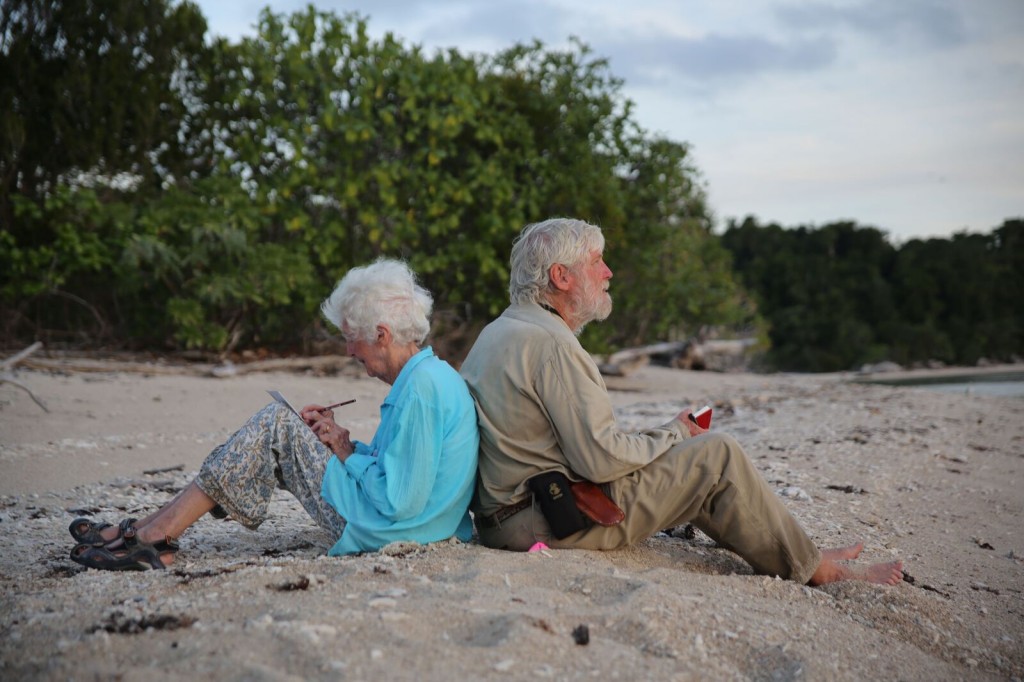A life of outstanding service to country and community
With the passing of Margaret Thorsborne we mourn the loss not only of our Society’s patron and one of its longest-serving members, but also one of Queensland’s most revered and beloved champions of our wildlife and natural heritage.
Born on 3 June 1927, Margaret was the daughter of Constance (nee Keys) and Lionel Kemp-Pennefather, both of whom had given extraordinary service in the most horrific arenas of the first world war: her father with the AIF and her mother with the Australian Army Nursing Service. Their influence on Margaret imbued her with a great compassion for others, a respect for life in all its forms, and a deep love of nature – and with this came an immense sense of responsibility. Seeing herself as a “protector not a protestor” Margaret was indefatigable in her defence of all wildlife species and their habitats, particularly those most vulnerable to human pressures. For Margaret our wetlands and waterways, islands and oceans, forests and woodlands, mangroves, estuaries, dunes and beaches were all a part of our “backyard” to be treated with sensitivity, understanding and the utmost care.
Margaret grew up in the Brisbane suburb of Toowong and, like her mother, trained as a nurse, later moving to Southport. In later life she often described the Gold Coast that she knew at that time as “one of the loveliest places on earth” with its wealth of wildflowers, paperbark woodlands, lagoons and clear-running creeks flowing down from the mountains of the hinterland. In 1963 she married schoolteacher Arthur Thorsborne creating an enduring partnership that was to become famous in conservation circles.
Inspired by such figures as artist and conservationist Kathleen McArthur and naturalist David Fleay, Margaret and Arthur became active members of the newly-formed Wildlife Preservation Society of Queensland. She was soon involved in early state-wide campaigns to protect the reef and rainforests, in practical projects conserving local habitats and encouraging community enthusiasm for native flora. The Pine Ridge Conservation Park at Runaway Bay, which today still protects an area of mostly vanished wallum country, is an early example of the Thorsborne legacy.
In 1964 the couple made their first visit to North Queensland to camp on Hinchinbrook Island, which they knew only from a few photographs. This was a life changer. Hinchinbrook had stolen their hearts and, after returning again and again on holiday, in 1972 a little cottage in the forest, just outside the coastal town of Cardwell, became their permanent home. Once again Margaret dedicated herself to protecting the wildlife and natural habitats of her new surroundings and promoting the conservation ethic within her local community. Her growing knowledge and love for the region made her only too aware of the damage that unchecked human activity, greed or thoughtlessness might do.
The couple were the first to bring attention to the plight of the Torresian imperial-pigeons that were being shot out of existence at their breeding colony on North Brook Island and in 1965 they began annual counts of the colony, starting what has become one of the world’s longest-running wildlife population surveys. Their actions to stop illegal shooting and protect the coastal forests on which the pigeons depended, saw the colony increase from under two thousand birds in 1968 to an average of between thirty and forty thousand birds by the turn of the century. The survival and recovery of this colony over the last 53 years is testimony to the Thorsbornes’ own commitment and their capacity to inspire and engage others within the community to join their endeavour. This remarkable story is told in the 2015 documentary The Coming of the White Birds.
The Thorsbornes’ desire to increase awareness of Hinchinbrook’s exquisite beauty, wilderness and wildlife values resulted in the publication of Hinchinbrook Island: the land time forgot in 1988. It is one of the most eloquent and comprehensive books of its kind and, three decades later, remains the definitive work on the Hinchinbrook region. But within a few years of Arthur’s death in 1991 she was to face her greatest challenge in resisting the threats posed to her beloved island, its waters and wildlife, by the “Port Hinchinbrook” marina/resort development which was growing like a boil on the shores of the Channel. Her courage, determination, resourcefulness and resilience were quite simply outstanding while her gentle smile and unfailing courtesy concealed a steely resolve. In a desperate attempt to prevent the destruction of mature stands of mangroves within a marine park she spent day after day in searing November heat trying to halt the bulldozer’s onslaught. At the same time she never ceased her polite but impassioned appeals to those in power to fulfil their national and international responsibilities to protect this area of the world’s heritage.
While her defence of Hinchinbrook and the North Brook pigeon colony might be considered Margaret’s most significant, indeed heroic, achievements there have been so many more. She worked unceasingly for threatened species not just in her own area but far beyond – the endangered bilbies and hairy-nosed wombats of western Queensland had a special place in her heart – and to protect and restore habitat wherever she could. The couple had long ago donated their own property to the national park estate and had played a major role in the creation of two national parks in the area. Much later her determined advocacy is credited with saving a vital area of woodland that was to become essential for early research into the endangered mahogany glider. And at every opportunity Margaret, a regular volunteer at community nurseries, was collecting seeds and nurturing seedlings for revegetation projects throughout the region.
Margaret’s significant contributions to science and education arose from her own observations and records, from years of botanical specimen collecting, from practical support to scientists and students, and from funding for research projects. Five species bear the Thorsborne name. This supportive, restorative and educational role was continued through the many activities of the Thorsborne Trust which Margaret established to commemorate her husband’s work. The Arthur Thorsborne Arboretum (a Trust initiative) provided educational opportunities for many groups of young people while creating a haven for wildlife on once neglected and impoverished land.
Margaret’s extensive and dedicated efforts brought numerous awards culminating in her investiture as an Officer of the Order of Australia in 2011. She became WPSQ patron in 2000, a most worthy successor to the Society’s founder, the late Judith Wright, and has been granted life membership of many environmental organisations.
As likely to be found planting trees as composing submissions or attending meetings, Margaret has always been both practical and visionary. Consequently, her environmental passion has been linked with concern for people whose lives or livelihoods might be affected by conservation measures. Her work yielded no financial reward and often came at considerable personal cost yet, even after the traumatic personal impact of cyclone Yasi which destroyed her home of 40 years, she persevered: striving to protect those species whose homes were also devastated.
Throughout her life Margaret displayed moral and physical courage, unflinching resolve and remarkable generosity and hospitality. Her advocacy was always honest, courteous and meticulously researched. Consequently, despite her natural reticence, she was increasingly respected and listened to by governments, decision-makers and the media. She constantly engaged with the community, its organisations and indigenous people, working as a self-effacing team member, imparting her message with patience and understanding. Her talents as a writer and artist conveyed the conservation message far and wide. Her beautifully illustrated envelopes, many of which have become collectors’ items, gently reminded recipients of the rights and needs of all living things. Her gift for friendship will always remain legendary and she forged many lasting and fruitful links among like-minded people. For forty years “Galmara”, her forest home, welcomed writers and artists, students, scientists, film-makers and anyone who needed a cup of tea, a helping hand or a bed for the night.
Remarkably she saw ageing as no excuse for pulling back from this responsibility to care for the world and all its diversity of life. Accepting the Vincent Serventy award in 1998 she said, “I think it’s time older people didn’t leave it to the young. We aren’t the last generation on earth but sometimes we act as if we are, with no thought for the future.” She often faced adversity, disappointment and sometimes heartbreak yet always found room for joy, love and frequent laughter. Her sense of humour and mischief was infectious and irresistible.
Margaret lived her life simply, with grace and humility, in absolute accord with her conservation principles – yet her influence was felt far beyond local boundaries. Indeed, where her work advanced the cause of threatened species, migratory birds or World Heritage areas it was of national and international importance. Margaret represented the epitome of what it is to be passionate, inspiring and committed and her life will long remain as an outstanding example of service to country and community.








